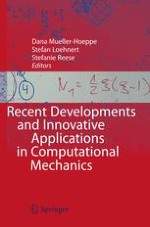2011 | OriginalPaper | Chapter
A Phenomenological Damage Model to Predict Material Failure in Crashworthiness Applications
Authors : Markus Feucht, Frieder Neukamm, André Haufe
Published in: Recent Developments and Innovative Applications in Computational Mechanics
Publisher: Springer Berlin Heidelberg
Activate our intelligent search to find suitable subject content or patents.
Select sections of text to find matching patents with Artificial Intelligence. powered by
Select sections of text to find additional relevant content using AI-assisted search. powered by
The present contribution will focus on one of the most urging challenges in crashworthiness simulations, namely alternative or enhanced constitutive for-mulations to predict failure and cracking of structural parts made from high strength steel sheets. In order to achieve a more accurate prediction, the consideration of pre-damage resulting from a foregoing deep-drawing process seems to be an important extension of the proven processes. This leads to the necessity of considering damage in Finite Element Simulations of forming processes, allowing for the results to be used further on in what has to become the simulation process chain of sheet metal part manufacturing. In a broader sense, this simulation process chain may be termed as “producibility-to-serviceability”. Up to now, the driving force behind forming simulations usually is the question if a certain part may be produced on certain press equipment with a defined number of forming stages, starting from specific sheet material of given initial thickness. Carrying over the forming results to other simulation disciplines, like crashworthiness or NVH, where the serviceability of the designed structure is investigated further, will eventually give more insight into the effects of pre-straining and possible pre-damaging emerging from the production process to the target discipline. Nowadays, the crashworthiness of bodies in white is assessed to a major extent by finite element simulations without taking the production history into account. Therefore, making use of pre-damage data offers promising opportunity to the simulation engineer to enhance simulation accuracy. Regarding this, experience shows that high strength steel qualities are expected to be more problematic. The present contribution discusses engineering driven approaches to improve the predictiveness of crashworthiness simulations, and to close the constitutive gap between the forming and crashworthiness world.
